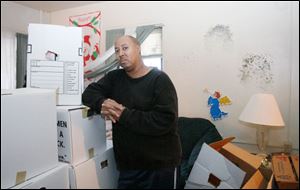
Residents affected by severe mold problem
12/18/2008
Anthony Palmer says he has tried to wash the large patches of mold from his living room and bedroom walls. Mr. Palmer said he is moving out next week and says he's glad to do so. He's blamed the mold for his frequent colds.
Several residents - and possibly many more - will have to be moved from their apartments at Brand Whitlock Homes because of problems with excessive mold.
Throughout the public housing complex, "mold is pervasive" and "can probably be found in more than half of the units," according to a study performed in November for the Lucas Metropolitan Housing Authority by HazCorp Environmental Services.
It estimated at least half of the units - about 150 - have "mold issues" and of those, at least 50 "are experiencing what could be considered serious mold problems." The study concludes "some of these units are not presently fit for human occupancy, many of these are currently vacant, however, some are still occupied."
Home to more than 300 families, Brand Whitlock is Toledo's oldest public housing complex; it opened in 1938.
A meeting is planned for 6 p.m. tonight at the Brand Whitlock Community Room, 642 Division St., to advise residents about the situation. The meeting is hosted by the Central Residents Council and the county housing authority.
LMHA Executive Director Linnie Willis said at least two residents have been moved and two others are in the process of moving.
"We do not want our residents living in those conditions," Mrs. Willis said yesterday at an agency board meeting.
She said the housing authority is trying to gauge the extent of the problem and urged residents to come to tonight's meeting.
Aneel Chablani, director of advocacy for Advocates for Basic Legal Equality, or ABLE, a law firm that represents low-income people, said the housing authority has been too slow to address the problem.
"We don't feel like there's an urgency to address this," Mr. Chablani said.
The housing authority has known about the problem since at least 2005, when an earlier study was conducted about mold.
"We are very concerned about the health risks and the exposure that has occurred to the residents over at least the last three years," Mr. Chablani said.
According to the 2008 study, mold can cause upper respiratory problems including nasal congestion, sneezing, running or itchy nose, exacerbating pre-existing asthma, wheezing, and coughing.
ABLE is calling for additional mold testing to be done throughout the complex, and a relocation plan is to be put in place to help residents who need to leave their homes.
The 2005 study said the problem was "a threat to the safety and welfare of the occupants and the conditions should be corrected as soon as possible."
Mrs. Willis, who did not become the agency's executive director until 2007, said she did not see a copy of the earlier study until last year. She said she does not know why the problem was not dealt with in 2005.
Because of the age of the buildings and other problems at Brand Whitlock, the housing authority has been hoping to redevelop the site, either with a massive renovation or just tearing down and building new.
Mrs. Willis said this problem validates the authority's concern that the buildings are functionally obsolete, and an investment should be made in new buildings rather than paying to modernize the old ones.
Both studies said the construction of the buildings contributes to mold growth. There is no insulating space between the exterior masonry walls and the interior walls, and the temperature inside the units changes rapidly. The buildings are heated with an antiquated boiler system using steam heat, which tends to add moisture, meaning the problem will be difficult to get rid of, the 2008 study stated.
Resident Anthony Palmer, who is moving out of his apartment next week, said he continuously tried washing away the large patches of mold in his living room and bedroom, but they kept returning. He said he is happy to be moving out, and believes the mold might have contributed to his catching frequent colds.
Because the buildings themselves are a factor, the mold could be a very difficult problem to tackle, Mrs. Willis said. While she emphasized the number of people impacted was still being determined, she said "massive relocation" of tenants could be necessary.
"But then the question becomes, where are all these people going to go?" she said.
The second study said the cost of getting rid of mold in 150 units could "easily escalate into an expenditure of hundreds of thousands of dollars." The agency's budget is already stretched, but Mrs. Willis said LMHA might be able to tap into an emergency reserve fund of several million dollars.
Two of the residents being relocated had not even complained about the mold at all, and the problem was only discovered because of a random inspection, Mrs. Willis said.
That was the case for Eloise Warner. Ms. Warner, who is moving out of her apartment at the end of the week, had lived there since 1994, she said.
She had never complained about the mold near her doorway, which she said she assumed was caused by some kind of leak, or the mold along her kitchen window. She said she doesn't believe she suffered any health problems as a result.
Mrs. Willis said she believes the authority needs to check every single unit. She also urged residents to speak up.
"We need people to come to the meeting," she said. "We need them to talk to us and help us make some decisions."
Contact Kate Giammarise at:
kgiammarise@theblade.com
or 419-724-6133.